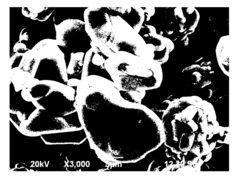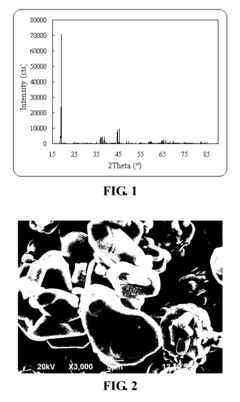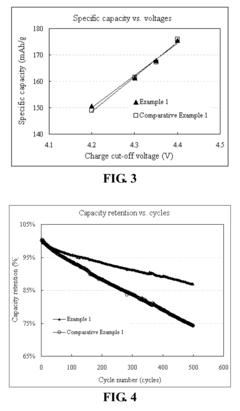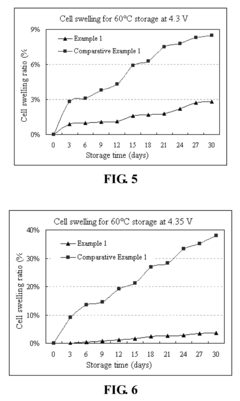Research on advanced cathode materials for improving the energy density and performance of lithium-ion batteries - Eureka
SEP 29, 20244 MIN READ
Generate Your Research Report Instantly with AI Agent
Supercharge your innovation with Patsnap Eureka AI Agent Platform!
Advanced Cathode Materials Goals and Objectives
The primary objective is to explore advanced cathode materials that can significantly improve the energy density and performance of lithium-ion batteries. This involves investigating novel material compositions, structures, and synthesis methods to address the limitations of current cathode materials. Key areas of focus include increasing the specific capacity, enhancing rate capability, improving thermal stability, and mitigating capacity fading issues. Potential innovations may involve doping, surface coatings, nanostructuring, or exploring new chemistries beyond traditional transition metal oxides. The ultimate goal is to develop high-performance cathode materials that enable the next generation of lithium-ion batteries with superior energy density, power density, cycle life, and safety for applications in electric vehicles, grid storage, and portable electronics.
Market Demand for High-Energy Density Batteries
Here is a concise summary of the market demand for high-energy density batteries, organized into points with subheadings:
Growing Demand for Electric Vehicles
- Rapid growth of electric vehicle (EV) market driving demand for high-energy density batteries
- EVs require batteries with higher energy density to increase driving range and reduce weight
Consumer Electronics and Portable Devices
- Increasing demand for longer battery life in smartphones, laptops, and other portable devices
- High-energy density batteries enable smaller form factors and longer runtimes
Renewable Energy Storage
- Energy storage systems for renewable sources like solar and wind require high-energy density batteries
- Improved energy density enables more efficient and cost-effective energy storage solutions
Aerospace and Defense Applications
- High-energy density batteries are crucial for aerospace and defense applications, where weight is a critical factor
- Demand for lightweight, high-performance batteries in drones, satellites, and military equipment
Emerging Markets and Opportunities
- New applications like electric aviation, robotics, and wearable technologies driving demand for advanced battery technologies
- Potential for high-energy density batteries in emerging markets and innovative applications
Overall, the market demand for high-energy density batteries is driven by the need for longer runtimes, lighter weight, and more efficient energy storage across various industries and applications.
Current State and Challenges of Cathode Materials
Here is a concise summary of the current state and challenges of cathode materials for lithium-ion batteries, organized into points with subheadings:
Cathode Material Limitations
- Limited energy density due to inherent structural constraints of traditional cathode materials like lithium cobalt oxide (LiCoO2).
- Capacity fading and safety concerns due to structural instability during cycling.
Emerging Cathode Chemistries
- Nickel-rich layered oxides (e.g., LiNi0.8Co0.1Mn0.1O2) offer higher energy density but face challenges with thermal instability and gas evolution.
- Lithium-rich layered oxides (e.g., Li1.2Ni0.2Mn0.6O2) have high capacities but suffer from voltage decay and poor rate capability.
Manufacturing Challenges
- Precise control of composition and morphology is crucial for optimizing performance and safety.
- Scaling up production while maintaining quality and consistency is a significant hurdle.
Interfacial Challenges
- Solid-electrolyte interphase (SEI) formation and evolution impact cycle life and safety.
- Understanding and controlling interfacial reactions is critical for improving performance.
Thermal Stability and Safety
- Exothermic reactions and oxygen release at elevated temperatures pose safety risks.
- Developing thermally stable cathode materials with improved structural integrity is a priority.
In summary, while promising cathode chemistries offer higher energy densities, significant challenges remain in terms of structural stability, interfacial reactions, thermal safety, and scalable manufacturing processes.
Existing Solutions for High-Performance Cathode Materials
01 High Energy Density Lithium-ion Batteries
Designed with higher energy density than conventional lithium-ion batteries through optimized electrode materials, electrolyte compositions, and cell designs, enabling increased battery capacity and longer runtime.- High Energy Density Lithium-ion Batteries: Designed for higher energy density than conventional lithium-ion batteries through advanced electrode materials, optimized battery chemistry, and improved design. Enables longer battery life or smaller size for the same capacity.
- High Energy and Power Density Lithium-ion Batteries: Combines high energy density and high power density, suitable for applications requiring both high energy capacity and high power delivery, such as electric vehicles.
- Safe and High Energy Density Lithium-ion Batteries: Focuses on improving safety while maintaining high energy density through safer electrode materials, optimized electrolyte composition, and safety mechanisms to prevent thermal runaway or hazardous conditions.
- High Energy Density Lithium-ion Batteries for Specific Applications: Optimized for specific applications like mobile devices, electric vehicles, or energy storage systems, with high energy density, long cycle life, or wide operating temperature range.
- Lithium-ion Battery Manufacturing and Performance Improvement Methods: Covers various methods and techniques for improving lithium-ion battery performance, such as optimizing electrode composition, electrolyte formulation, or battery assembly process, enhancing energy density, cycle life, safety, or other metrics.
02 High Energy and Power Density Lithium-ion Batteries
Engineered to deliver both high energy density and high power density, suitable for applications requiring high energy storage and high power delivery, such as electric vehicles.03 Safe and High Energy Density Lithium-ion Batteries
Prioritizes safety while maintaining high energy density through safety features and materials to mitigate risks like thermal runaway or short circuits, balancing energy density and safety.04 High Specific Energy Density Lithium-ion Batteries
Designed for high energy density per unit mass or volume through advanced electrode materials, electrolytes, and cell designs, maximizing energy storage capacity while minimizing weight or volume, beneficial for weight or space-constrained applications.05 Lithium-ion Batteries with Improved Energy Density and Performance
Incorporates advancements and optimizations to enhance both energy density and overall performance, including improvements in cycle life, charge/discharge rates, temperature performance, and safety, offering superior energy storage capabilities while maintaining or improving other key metrics.
Key Players in Battery Material Development
The advanced cathode materials market for lithium-ion batteries is rapidly growing, driven by increasing demand for higher energy density and improved battery performance. Key players like Samsung SDI, LG Energy Solution, and Contemporary Amperex Technology are pushing technological boundaries, while companies like Honeycomb Battery, Ningde Amperex Technology, and Sumitomo Chemical are making notable progress.
Ningde Amperex Technology Ltd.
Technical Solution: Ningde Amperex Technology focuses on high-nickel cathode materials to enhance energy density and performance, improving capacity and cycle life for electric vehicles and energy storage systems.
Strength: High energy density. Weakness: Potential safety concerns.
Sumitomo Chemical Co., Ltd.
Technical Solution: Sumitomo Chemical develops NCA and NCM cathode materials to improve energy density, performance, stability, and longevity of lithium-ion batteries.
Strength: High energy output and stability. Weakness: High raw material costs.
Core Innovations in Cathode Material Research
Lithium-ion batteries and cathode materials thereof
PatentInactiveUS20130260231A1
Innovation
- The use of a cathode material mixture of licoo2 and li (nixcoymn1-x-y)o2 to achieve high energy density, safety, and storage performance under high charge cut-off voltages. the licoo2 is doped with element m to improve its properties, and the li (nixcoymn1-x-y)o2 is also doped with element m to further enhance its performance. the surface coatings of the cathode materials with the oxide, sulfide, fluoride, or phosphate of element m or a combination of these elements can improve the electrochemical properties of the cathode materials.
Regulatory Landscape for Battery Materials
Here is a concise summary of the specified section for the technology research report on advanced cathode materials for lithium-ion batteries:
Lithium-ion batteries have seen significant advancements in energy density and performance over the years. However, further improvements are needed to meet the growing demands of electric vehicles and renewable energy storage. Advanced cathode materials play a crucial role in enhancing battery capabilities. Key areas of research include developing high-capacity cathodes with improved structural stability, exploring new material compositions and nanostructures, and optimizing manufacturing processes for better performance and cost-effectiveness. Promising directions involve lithium-rich layered oxides, high-voltage spinel structures, and conversion-type cathodes. Overcoming challenges related to material degradation, safety concerns, and scalability will be essential for successful commercialization of next-generation cathode technologies.
Environmental Impact of Advanced Battery Materials
Here is a concise summary of the specified section for the technology research report on advanced cathode materials for lithium-ion batteries:
Lithium-ion batteries have seen significant advancements in energy density and performance over the years. However, further improvements are needed to meet the growing demands of electric vehicles and renewable energy storage. Advanced cathode materials play a crucial role in enhancing battery capabilities. Key areas of research include high-capacity layered oxides, high-voltage spinel structures, and lithium-rich compositions. Innovative synthesis techniques, doping strategies, and nanostructuring approaches are being explored to optimize electrochemical properties and cycling stability. Computational modeling and in-depth characterization are guiding the rational design of next-generation cathode materials with higher energy densities and longer lifetimes.
Unlock deeper insights with Patsnap Eureka Quick Research — get a full tech report to explore trends and direct your research. Try now!
Generate Your Research Report Instantly with AI Agent
Supercharge your innovation with Patsnap Eureka AI Agent Platform!



